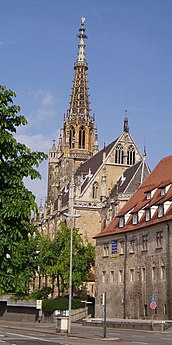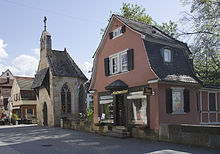Religions in Esslingen
Around 2000, around 39% (35,100) of the residents of the Baden-Württemberg district town of Esslingen were Protestant, around 27% (24,300) were Catholic. There is also a Greek Orthodox community , Muslims, Jews and many smaller communities in the city. According to the census on May 9, 2011, 23.1% of the population were Roman Catholic, 32.8% Protestant and 44.2% belonged to other denominations or religious communities or were non-denominational.
The Catholics
According to the census on May 9, 2011, 23.1% of the population were Roman Catholic. When Esslingen was first mentioned in 777, the church belonged to the abbot Fulrad of Saint-Denis, who bequeathed the cella along with the remains of the martyr Vitalis to the Merovingian abbey of Saint-Denis near Paris in the event of his death . Esslingen developed into a heavily visited place of pilgrimage . Around 800, Esslingen received market rights , probably to secure the monastery’s income and supplies for the pilgrims.
In 1213 Emperor Friedrich II donated the Esslingen city church to the Speyer cathedral chapter .
In the 13th century, the construction of many large buildings began in Esslingen. Monasteries were built, the bridge over the Neckar dates from this time and the St. Vitalis Church was expanded. In 1229, the Esslingen city charter and the office of mayor were mentioned for the first time in a donation to the Salem monastery .
With the wealth came the counter-movement of the mendicant orders into the city. Dominicans , Franciscans, and Carmelites , among others, preached poverty, repentance, and concern for salvation. They received large donations and estates in abundance, with which they built monasteries and churches.
The population of Esslingen belonged to the diocese of Constance and was assigned to the archdeaconate of Alb. Esslingen was the seat of the Esslingen Regional Chapter. After the introduction of the Reformation , Esslingen was a predominantly Protestant city for many centuries, but there were always a few Catholics. They were able to hold their services in the Marienkapelle at Kaisheimer Pflegehof. In 1806 a Catholic parish was officially established again. This celebrated service in the church of the Katharinenspital until it was demolished in 1811, then in the Frauenkirche. In 1821 the community came to the newly founded diocese of Rottenburg. In 1861 the community was able to acquire the former Dominican Church of St. Paul , which was consecrated as a Catholic parish church in 1864. During the renovation period, the parish used the Franciscan church from 1860 to 1864. From the middle of the 20th century, mainly because of the influx of Catholic refugees and expellees, further Catholic parishes were founded in the Esslingen districts, which today form pastoral care units 8 and 9 within the Catholic Dean's Office of Esslingen-Nürtingen of the Rottenburg-Stuttgart diocese . The pastoral care unit 8 includes the
- Munster St. Paul on the market square the parishes
- St. Josef in Hohenkreuz (church from 1957),
- Maria Hilfe der Christisten in Mettingen (church from 1952) and
- St. Elisabeth in the Pliensauvorstadt (church from 1966).
The parishes belong to pastoral care unit 9
- St. Maria Sorrowful Mother in Berkheim (church from 1975),
- Albertus Magnus in Oberesslingen (church from 1947/48),
- On the Holy Trinity in Zell (church from 1966/67) and
- St. Augustine in Zollberg (church from 1959).
The Protestants
- woman Church
The first Protestant pastor was employed in Esslingen in 1526. From 1531 free sermon was allowed and the reformer Ambrosius Blarer was hired. In 1532 the interior of the churches was destroyed in an iconoclasm. In 1531 Esslingen joined the Schmalkaldic Union of Protestants. When the subsequent war against Charles V was lost, the reading of the mass had to be tolerated again in the city from 1548 . In 1551, however, Protestant services were held again in Esslingen . After that, the Lutheran creed more and more prevailed and Esslingen was a predominantly Protestant city for many centuries. As a free imperial city , Esslingen could also regulate church affairs itself. From 1698, a superintendent , also known as a senior, was at the head of the church in Esslingen . After the transition to Württemberg in 1802, Esslingen became the seat of a deanery ( church district Esslingen ), the previous senior at the city church of St. Dionysius became dean. In addition to the city church, there were two other Protestant churches in the city center, namely the Frauenkirche (1811–1864 Catholic church), which is now the center of its own Protestant parish , and the rear church (former Franciscan monastery church), whose nave was dilapidated at the beginning of the 19th century however had to be canceled; the choir was integrated into the Evangelical Parish Hall in 1840. Some of the districts of Esslingen also had their own churches, or new churches were built later and their own parishes were established. Today a total of 13 parishes make up the Evangelical Overall Church Community of Esslingen. In addition to the parish of St. Dionysiums and the Frauenkirgemeinde , these are (alphabetical list):
- Parish Hegenberg-Liebersbronn (church and parish from 1927 and new church of 1959)
- Parish High Cross (Church of 1956/57)
- Johanneskirchengemeinde (church built in 1909 as "Eastern Church", Johanneskirche since 1939)
- Parish Mettingen (Gothic church with attached tower of the 15th century, until 1902 Branch of St. Dionysius, only their own parish, the community includes Brühl and Weil, 1962 Construction of the St. Luke's Church in Weil)
- Oberesslingen Martinskirchengemeinde (church from 1827, but there was already a church in the 14th century)
- Oberesslingen Reconciliation Parish (church from 1972)
- Oberesslingen garden town parish (church from 1952 to 2008, Protestant garden town house from 2009) Sirnau also belongs to the community
- Parish of St. Bernhardt (church from 1774, expanded in 1889, the previous church of St. Bernhardt was destroyed in the Thirty Years' War, but the tower was preserved) The parish also includes Wäldenbronn, Kennenburg, Serach and Wiflingshausen
- Southern parish in the Pliensauvorstadt (church from 1925/26)
- Parish Sulzgries (Church Sulzgries of 1839; the old Trinity Church Rüdern was first mentioned in 1473, renewed in 1805, 1839 rebuilt as a farmhouse and discontinued in 1841) for the church includes Rüdern, Krummacker and Neckarhalde
- Parish Zollberg (Christ Church built in 1963)
The three Oberesslingen parishes have been merged into one parish.
There are also Protestant parishes in the two districts of Berkheim and Zell, which were recently incorporated into Esslingen, since the places belonged to Württemberg early on and the Reformation was introduced here as well. Berkheim was a branch of Denkendorf for a long time , from 1839 of Nellingen and has only been an independent parish since 1889. The congregation celebrates its services in a church of Romanesque origin that was rebuilt or renovated in 1841, 1879 and 1929. In 1977, the Osterfeldkirche with community center was built as the second church. Zell has a late Gothic parish church with a high Gothic east choir. The ship was renewed in 1877.
All the parishes mentioned in the Esslingen city area belong to the Esslingen deanery within the Evangelical Church in Württemberg . There are also some Protestant communities, including the South German Community .
Free Churches
As early as 1527 a community of the Reformation Anabaptists was formed , against which six death sentences were taken in 1529. One of their preachers was Hans Leupold , who was executed in Augsburg in 1528 after a council judgment . Anabaptists were arrested in Esslingen in 1598.
Today, in addition to the Lutherans of the Evangelical Church in Württemberg, who make up the majority of Protestant Christians in Esslingen, there are many, in some cases significant, representative offices of free churches in Esslingen . These include the United Methodist Church (since 1860), the Evangelical Free Church Congregation (Baptists), the Seventh-day Adventist Community (since 1920) and the popular mission of committed Christians .
In addition, the New Apostolic Church since 1905, Christian Science since 1920, the Church of Jesus Christ of Latter-day Saints since 1922, the Christian Community since 1922, and Jehovah's Witnesses since 1930 have been represented in Esslingen. Furthermore, a Christadelphian community has its seat in the Wäldenbronn district .
The Greek Orthodox
Esslingen is home to the Church of the Annunciation, the largest Greek Orthodox church in Europe outside of Greece. The three-aisled basilica was completed in 1995. The massive concrete building was artfully clad and painted in the classic Orthodox manner. The apse shows the enthroned Mother of God with the baby Jesus, at her side the archangels Michael and Gabriel . The dome painting shows Christ as Pantocrator .
The Jews
The synagogue in Heppächer was desecrated during the Reichspogromnacht from November 9th to 10th, 1938 . People who were considered Jews according to Nazi ideology were deported to the east for extermination. Today (2012) Esslingen has more than 200 citizens who profess the Jewish faith. At the beginning of 2012, the former synagogue building in Heppächer was transferred back to the Israelite religious community of Württemberg in the form of a heritable building right. The establishment of a community center is planned here.
The Muslims
At the beginning of the 2000s, the Diyanet association applied for the construction of a mosque in Esslingen. The motion sparked controversial discussions about Christianity and Islam . After September 11, 2001 , fear of terrorist acts by Islamic fundamentalists also played a major role in the discussion . However, the association already distanced itself several times before the Koran was misused for political and violent purposes .
For the mosque in Rennstrasse 9, in addition to a prayer room (440 m²), an event hall, tea room, classrooms, youth room, meeting rooms, underground car park (32 parking spaces), etc. are planned. There is also a minaret (25 m high).
The mosque planned by the architects K + Ü Architekten was approved. The groundbreaking ceremony took place on May 6, 2006, and the shell has been completed since summer 2008 . Donations are currently being collected for the interior work.
The Baha'i
There is also a small Baha'i community that has its center in the Krummenacker district. Esslingen is of particular historical importance for them because 'Abdul-Baha' visited the city in 1913. A children's festival was held in his honor in the Altes Museum (today the Reichsstadt restaurant). In January 2003, the Baha'i community organized a multi-religious peace prayer in the Frauenkirche together with the Protestant and Catholic parishes as well as the Muslim community.
literature
- Otto Schuster: Church history of the city and district of Esslingen . Calwer Verlag Stuttgart, 1946
Web links
- Evangelical church district Esslingen
- Total Catholic parish in Esslingen
- Greek Orthodox Church of the Annunciation in Esslingen
- South German Community Esslingen
- Evangelical Free Church Community Esslingen (Baptists) - Meeting Church
- DITIB Turkish-Islamic Cultural Association Esslingen (islam) - Esslingen Mosque
Individual evidence
- ^ Population in a regional comparison by religion -in% - City of Esslingen , accessed on October 4, 2019
- ^ Population in a regional comparison by religion -in% - City of Esslingen , accessed on October 4, 2019
- ↑ Joachim J. Half Can: The Reformation in Esslingen
- ^ Entry in the Global Anabaptist Mennonite Encyclopedia
- ^ Return of Jewish life to Esslingen. Reported to haGalil.com on February 4, 2012.




